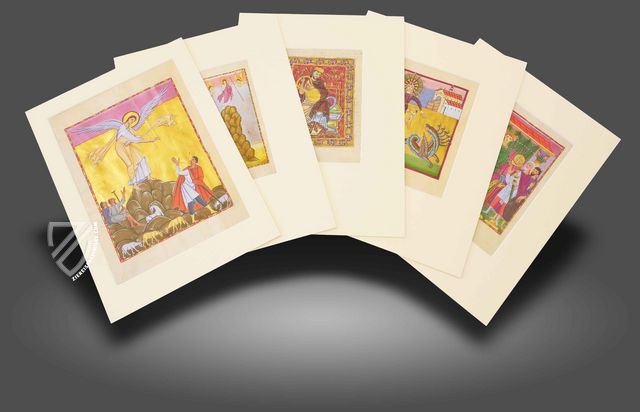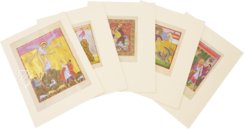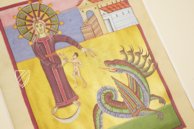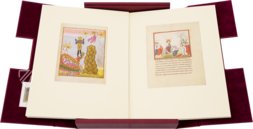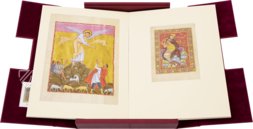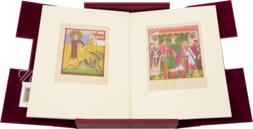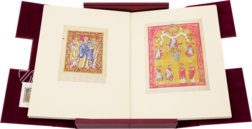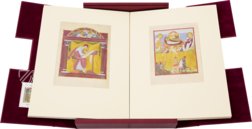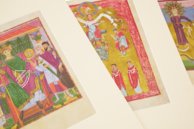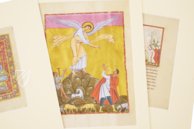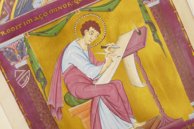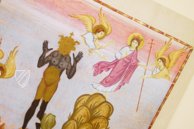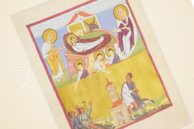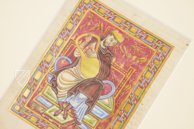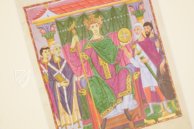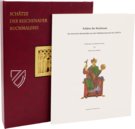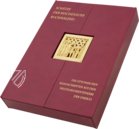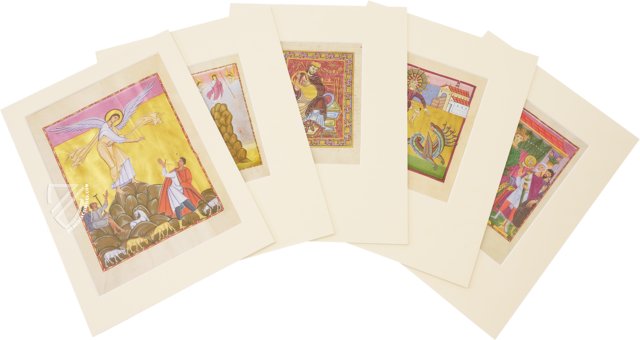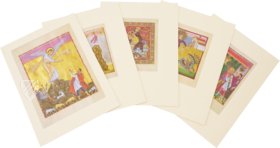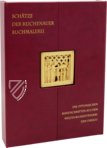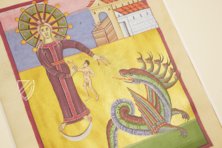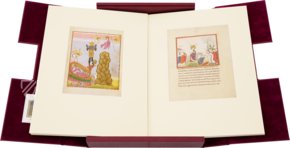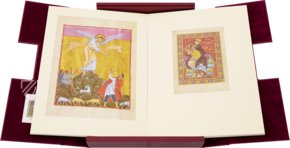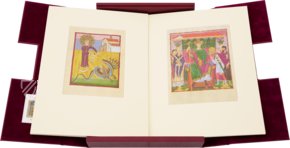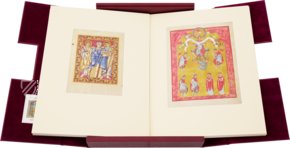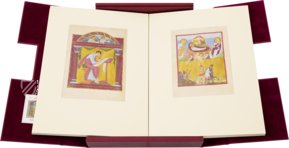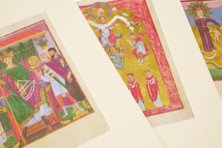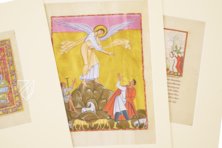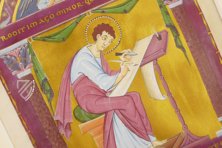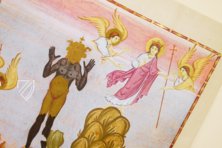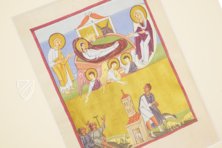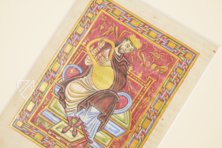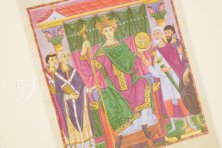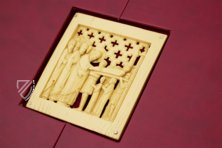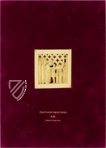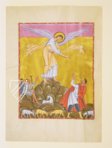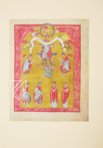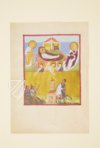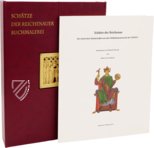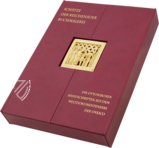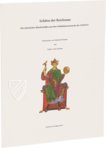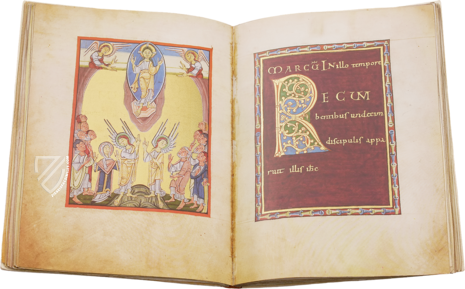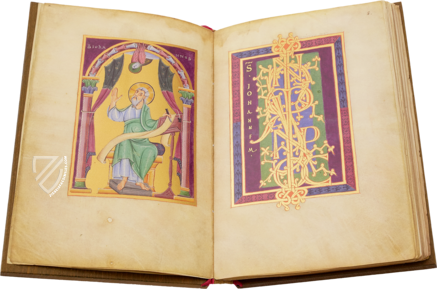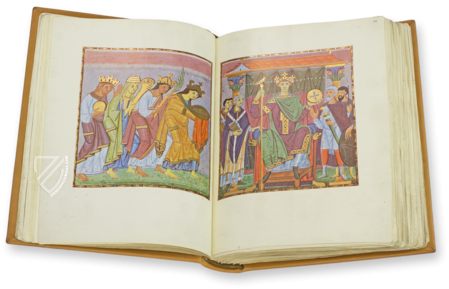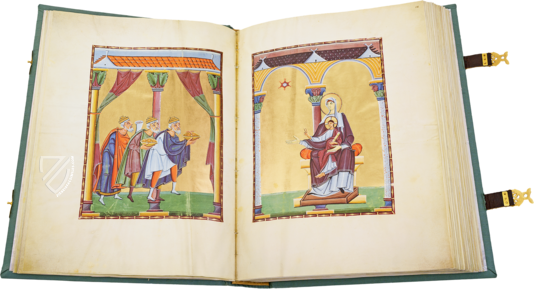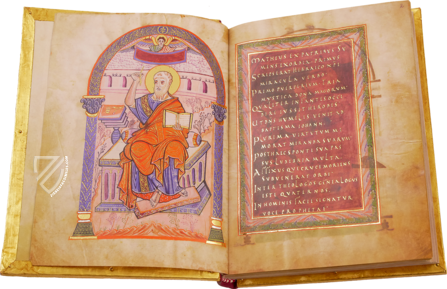Treasures of Ottonian Illumination (Collection)
(1,000€ - 3,000€)
The Ottonian Renaissance produced some of the greatest, most lavishly adorned and bound masterpieces of the entire Middle Ages. It was a rich but relatively short-lived renaissance associated with the Ottonian dynasty (919-1024), but which outlived them, gradually evolving into the German Romanesque. Stylistically, Ottonian manuscripts built on Carolingian traditions and consciously sought to imitate Late Antique and Byzantine artistic traditions. Ottonian Illumination is characterized by rich materials like Byzantine-style burnished gold backgrounds, gold and silver ink, and rich, flat colors from exotic materials. This grand, monumental style of illumination was an expression of a renewed belief in the Holy Roman Empire, and a desire to be seen as equals by the Byzantines. Thus, splendid codices from that time were also used as political statements, and in their paintings the Ottonian kings and emperors had themselves crowned by God.
Treasures of Ottonian Illumination (Collection)
Vibrant colors made from precious pigments, extensive use of highly burnished gold, and stylized figures: an expressive style of painting brought to the highest perfection! Even today, one cannot help but to be enthralled by the lavishly illuminated deluxe manuscripts, which the monks on the island of Reichenau created for the Ottonian rulers as well as for important patrons of the imperial court in the 10th and 11th centuries. In fact, Reichenau Monastery was at the center of Ottonian art and the illuminated manuscripts produced by the so-called Reichenau school during this period continue to fascinate people today. Every page of these manuscripts evokes a solemn aura of the sublime and the sacred. In 2003, the UNESCO committee decided to inscribe ten of these works on the Memory of the World Register. The facsimile cassette published by Quaternio Editions Lucerne provides an insight into the wonderful imagery of these Ottonian masterpieces.
A Grand and Monumental Style
Ottonian art was produced primarily in modern Germany as well as northern Italy and the Low Countries. A continuation of Carolingian Illumination, Ottonian Illumination was strongly influenced by Late Antique and Byzantine Art, looking to them both for aesthetic inspiration and for the political implications of these classical forms as the kings of Germany claimed the mantle of Roman Emperor. Its compositions appear static, often relying on expressive glances and gestures with elongated fingers. Some Insular influences can also be seen in Ottonian art, especially with regard to marginal interlace patterns, large decorative initials, and incipit pages in particular. Ottonian Illumination is distinguished by a grand aesthetic, sometimes cumbersome in its early period, but then ca. 1000 "a solemn monumentality is combined with a vibrant inwardness, an unworldly, visionary quality with sharp attention to actuality, surface patterns of flowing lines and rich bright colors with passionate emotionalism". Often furnished with luxurious bindings, Ottonian manuscripts are counted among some of the greatest masterpieces in all of medieval manuscript art.
Masterpieces from Reichenau
Illuminated manuscripts made at Reichenau Abbey are among the most magnificent works of art created under the Ottonian monarchs. At that time, the Benedictine Abbey on the island of Reichenau in Lake Constance was one of the major cultural and scholarly centers of the East Frankish Empire. The scriptorium housed at Reichenau Abbey produced deluxe manuscripts of great beauty with an aesthetic that markedly influenced Ottonian art. The Abbey of Reichenau was founded in 724 by Saint Pirmin (d. 753), a Hiberno-Frankish itinerant Bishop, on an island in Lake Constance. Under Charlemagne, the abbey ranked among the great Frankish imperial monasteries and gained even more influence under the Ottonian dynasty. The scriptorium produced illuminated manuscripts of outstanding artistic quality for emperors, kings, and members of the higher clergy under the abbots Witigowo, Immo, and Berno (985-1048) in particular. At least 58 deluxe manuscripts from the ‘Reichenau School’ have survived to the present, but only seven of these works record the names of their scribes and illuminators been preserved.
This compendium of single sheets mounted on boards and suitable for framing consists of ten outstanding specimens of Ottonian illumination from the following manuscripts:
Bamberger Daniel-Kommentar - Bamberg, Staatsbibliothek Bamberg, Msc. Bibl. 22
Bamberg Apocalypse - Bamberg, Staatsbibliothek Bamberg, Msc. Bibl. 140
Gospel Book of Otto III - Münich, Bayerische Staatsbibliothek, Clm 4453
Evangeliar aus dem Bamberger Dom - Münich, Bayerische Staatsbibliothek, Clm 4454
Pericopes of Henry II - Münich, Bayerische Staatsbibliothek München, Clm 4452;
Codex Egberti - Trier, Stadtbibliothek Weberbach, Hs. 24
Egbert-Psalter - Cividale del Friuli, Museo Archeologico Nazionale di Cividale del Friuli, Ms. 136
Evangelistar von Poussay - Bibliothèque nationale de France, Ms. lat. 10514;
Evangeliar Ottos III. (Liuthar- Evangeliar) - Domschatzkammer Aachen, G 25.
Codicology
- Alternative Titles
- Schätze der Reichenauer Buchmalerei
Schätze der Reichenauer Buchmalerei - Die ottonischen Handschriften aus dem Weltdokumentenerbe der UNESCO - Size / Format
- 10 leaves / 42.5 × 23.5 cm
- Origin
- Germany
- Date
- 10–11th century
- Style
- Genre
- Language
- Illustrations
- 10 miniatures
- Content
- Ten leaves from important Ottonian manuscripts:
Bamberger Daniel-Kommentar (Msc. Bibl. 22 - Staatsbibliothek Bamberg)
Bamberg Apocalypse (Msc. Bibl. 140 - Staatsbibliothek Bamberg)
Gospels of Otto III (Clm 4453 - Bayerische Staatsbibliothek)
Evangeliar
Treasures of Ottonian Illumination (Collection)
Entry into Jerusalem – Codex Egberti
Christ’s triumphal entry into Jerusalem, celebrated each year on Palm Sunday, marks the beginning of the Passion cycle. Christ is depicted riding on a humble donkey, which symbolizes peace in contrast to a mighty warhorse. He is followed by a procession of his barefooted disciples and is greeted by the shod citizens of Jerusalem. They are depicted presumably greeting the entourage outside of the city because no architectures can be seen, just a very inaccurate-looking palm tree. Some of the people break off branches from the tree to throw onto the road alongside their colorful cloaks; all of them are dressed in classical Roman robes.
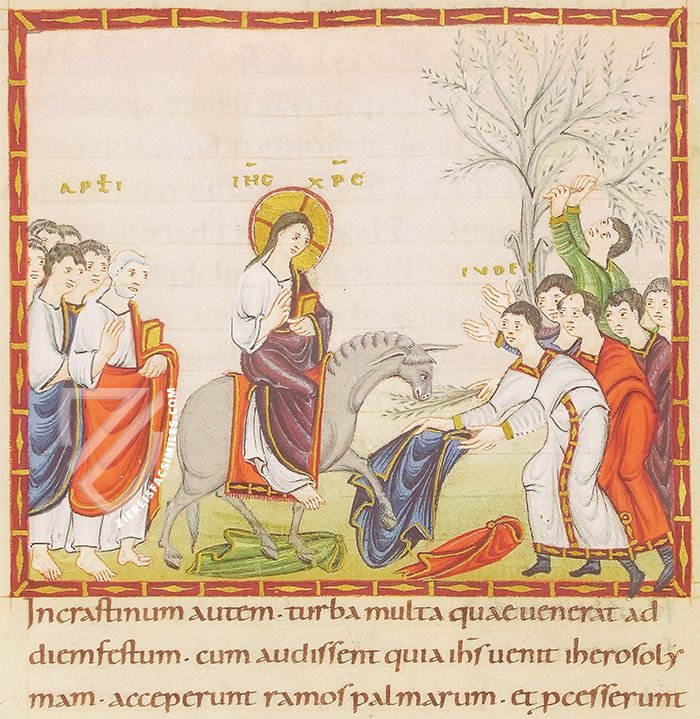
Treasures of Ottonian Illumination (Collection) – Gospels of Otto III
Patron Portrait of Otto III
This brightly-colored double-page miniature is a masterpiece of Ottonian illumination and a famous representation of the power of the Holy Roman Empire. The artists of Reichenau’s scriptorium drew from Byzantine and Carolingian examples, both of which were firmly rooted in the style of Late Antiquity. Thus, Otto is formidably presented in the purple robes of a Roman emperor.
Otto is enthroned with the imperial crown, orb, and eagle scepter of Augustus. He is flanked by clerics to the left and noble knights to the right. Four figures representing the peoples of the empire – Sclavinia, Germania, Gallia, and Roma – humbly approach with gifts consisting of a shell filled with gems, a palm branch, a cornucopia, and a golden globe.
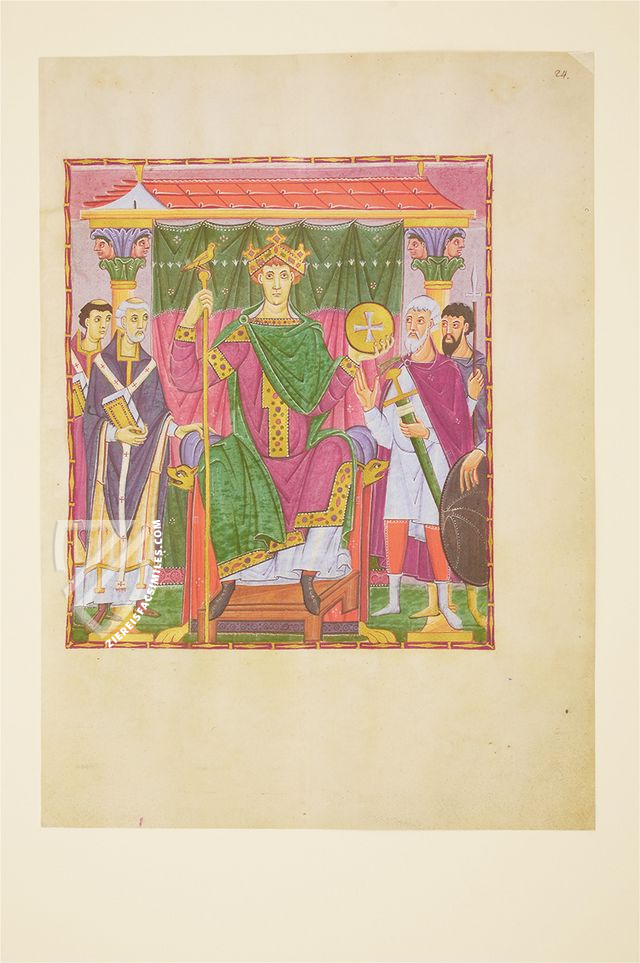
#1 Schätze der Reichenauer Buchmalerei - Die ottonischen Handschriften aus dem Weltdokumentenerbe der UNESCO
(1,000€ - 3,000€)
- Treatises / Secular Books
- Apocalypses / Beatus
- Astronomy / Astrology
- Bestiaries
- Bibles / Gospels
- Chronicles / History / Law
- Geography / Maps
- Saints' Lives
- Islam / Oriental
- Judaism / Hebrew
- Single Leaf Collections
- Leonardo da Vinci
- Literature / Poetry
- Liturgical Manuscripts
- Medicine / Botany / Alchemy
- Music
- Mythology / Prophecies
- Psalters
- Other Religious Books
- Games / Hunting
- Private Devotion Books
- Other Genres
- Afghanistan
- Armenia
- Austria
- Belgium
- Belize
- Bosnia and Herzegovina
- China
- Colombia
- Costa Rica
- Croatia
- Cyprus
- Czech Republic
- Denmark
- Egypt
- El Salvador
- Ethiopia
- France
- Germany
- Greece
- Guatemala
- Honduras
- Hungary
- India
- Iran
- Iraq
- Israel
- Italy
- Japan
- Jordan
- Kazakhstan
- Kyrgyzstan
- Lebanon
- Liechtenstein
- Luxembourg
- Mexico
- Morocco
- Netherlands
- Palestine
- Panama
- Peru
- Poland
- Portugal
- Romania
- Russia
- Serbia
- Spain
- Sri Lanka
- Sweden
- Switzerland
- Syria
- Tajikistan
- Turkey
- Turkmenistan
- Ukraine
- United Kingdom
- United States
- Uzbekistan
- Vatican City
- A. Oosthoek, van Holkema & Warendorf
- Aboca Museum
- Ajuntament de Valencia
- Akademie Verlag
- Akademische Druck- u. Verlagsanstalt (ADEVA)
- Aldo Ausilio Editore - Bottega d’Erasmo
- Alecto Historical Editions
- Alkuin Verlag
- Almqvist & Wiksell
- Amilcare Pizzi
- Andreas & Andreas Verlagsbuchhandlung
- Archa 90
- Archiv Verlag
- Archivi Edizioni
- Arnold Verlag
- ARS
- Ars Magna
- ArtCodex
- AyN Ediciones
- Azimuth Editions
- Badenia Verlag
- Bärenreiter-Verlag
- Belser Verlag
- Belser Verlag / WK Wertkontor
- Benziger Verlag
- Bernardinum Wydawnictwo
- BiblioGemma
- Biblioteca Apostolica Vaticana (Vaticanstadt, Vaticanstadt)
- Bibliotheca Palatina Faksimile Verlag
- Bibliotheca Rara
- Boydell & Brewer
- Bramante Edizioni
- Bredius Genootschap
- Brepols Publishers
- British Library
- C. Weckesser
- Caixa Catalunya
- Canesi
- CAPSA, Ars Scriptoria
- Caratzas Brothers, Publishers
- Carus Verlag
- Casamassima Libri
- Centrum Cartographie Verlag GmbH
- Chavane Verlag
- Christian Brandstätter Verlag
- Circulo Cientifico
- Club Bibliófilo Versol
- Club du Livre
- CM Editores
- Collegium Graphicum
- Collezione Apocrifa Da Vinci
- Comissão Nacional para as Comemorações dos Descobrimentos Portugueses
- Coron Verlag
- Corvina
- CTHS
- D. S. Brewer
- Damon
- De Agostini/UTET
- De Nederlandsche Boekhandel
- De Schutter
- Deuschle & Stemmle
- Deutscher Verlag für Kunstwissenschaft
- DIAMM
- Droz
- E. Schreiber Graphische Kunstanstalten
- Ediciones Boreal
- Ediciones Grial
- Ediclube
- Edições Inapa
- Edilan
- Editalia
- Edition Deuschle
- Edition Georg Popp
- Edition Leipzig
- Edition Libri Illustri
- Editiones Reales Sitios S. L.
- Éditions de l'Oiseau Lyre
- Editions Medicina Rara
- Editorial Casariego
- Editorial Mintzoa
- Editrice Antenore
- Editrice Velar
- Edizioni Edison
- Egeria, S.L.
- Eikon Editores
- Electa
- Emery Walker Limited
- Enciclopèdia Catalana
- Eos-Verlag
- Ephesus Publishing
- Ernst Battenberg
- Eugrammia Press
- Extraordinary Editions
- Fackelverlag
- Facsimila Art & Edition
- Facsimile Editions Ltd.
- Facsimilia Art & Edition Ebert KG
- Faksimile Verlag
- Feuermann Verlag
- Folger Shakespeare Library
- Franco Cosimo Panini Editore
- Friedrich Wittig Verlag
- Fundación Hullera Vasco-Leonesa
- G. Braziller
- Gabriele Mazzotta Editore
- Gebr. Mann Verlag
- Gesellschaft für graphische Industrie
- Getty Research Institute
- Giovanni Domenico de Rossi
- Giunti Editore
- Graffiti
- Grafica European Center of Fine Arts
- Guido Pressler
- Guillermo Blazquez
- Gustav Kiepenheuer
- H. N. Abrams
- Harrassowitz
- Harvard University Press
- Helikon
- Hendrickson Publishers
- Henning Oppermann
- Herder Verlag
- Hes & De Graaf Publishers
- Hoepli
- Holbein-Verlag
- Houghton Library
- Hugo Schmidt Verlag
- Idion Verlag
- Il Bulino, edizioni d'arte
- ILte
- Imago
- Insel Verlag
- Insel-Verlag Anton Kippenberger
- Instituto de Estudios Altoaragoneses
- Instituto Nacional de Antropología e Historia
- Introligatornia Budnik Jerzy
- Istituto dell'Enciclopedia Italiana - Treccani
- Istituto Ellenico di Studi Bizantini e Postbizantini
- Istituto Geografico De Agostini
- Istituto Poligrafico e Zecca dello Stato
- Italarte Art Establishments
- Jan Thorbecke Verlag
- Johnson Reprint Corporation
- Josef Stocker
- Josef Stocker-Schmid
- Jugoslavija
- Karl W. Hiersemann
- Kasper Straube
- Kaydeda Ediciones
- Kindler Verlag / Coron Verlag
- Kodansha International Ltd.
- Konrad Kölbl Verlag
- Kurt Wolff Verlag
- La Liberia dello Stato
- La Linea Editrice
- La Meta Editore
- Lambert Schneider
- Landeskreditbank Baden-Württemberg
- Leo S. Olschki
- Les Incunables
- Liber Artis
- Library of Congress
- Libreria Musicale Italiana
- Lichtdruck
- Lito Immagine Editore
- Lumen Artis
- Lund Humphries
- M. Moleiro Editor
- Maison des Sciences de l'homme et de la société de Poitiers
- Manuscriptum
- Martinus Nijhoff
- Maruzen-Yushodo Co. Ltd.
- MASA
- Massada Publishers
- McGraw-Hill
- Metropolitan Museum of Art
- Militos
- Millennium Liber
- Müller & Schindler
- Nahar - Stavit
- Nahar and Steimatzky
- National Library of Wales
- Neri Pozza
- Nova Charta
- Oceanum Verlag
- Odeon
- Orbis Mediaevalis
- Orbis Pictus
- Österreichische Staatsdruckerei
- Oxford University Press
- Pageant Books
- Parzellers Buchverlag
- Patrimonio Ediciones
- Pattloch Verlag
- PIAF
- Pieper Verlag
- Plon-Nourrit et cie
- Poligrafiche Bolis
- Presses Universitaires de Strasbourg
- Prestel Verlag
- Princeton University Press
- Prisma Verlag
- Priuli & Verlucca, editori
- Pro Sport Verlag
- Propyläen Verlag
- Pytheas Books
- Quaternio Verlag Luzern
- Reales Sitios
- Recht-Verlag
- Reichert Verlag
- Reichsdruckerei
- Reprint Verlag
- Riehn & Reusch
- Roberto Vattori Editore
- Rosenkilde and Bagger
- Roxburghe Club
- Salerno Editrice
- Saltellus Press
- Sandoz
- Sarajevo Svjetlost
- Schöck ArtPrint Kft.
- Schulsinger Brothers
- Scolar Press
- Scrinium
- Scripta Maneant
- Scriptorium
- Shazar
- Siloé, arte y bibliofilia
- SISMEL - Edizioni del Galluzzo
- Sociedad Mexicana de Antropología
- Société des Bibliophiles & Iconophiles de Belgique
- Soncin Publishing
- Sorli Ediciones
- Stainer and Bell
- Studer
- Styria Verlag
- Sumptibus Pragopress
- Szegedi Tudomànyegyetem
- Taberna Libraria
- Tarshish Books
- Taschen
- Tempus Libri
- Testimonio Compañía Editorial
- Thames and Hudson
- The Clear Vue Publishing Partnership Limited
- The Facsimile Codex
- The Folio Society
- The Marquess of Normanby
- The Richard III and Yorkist History Trust
- Tip.Le.Co
- TouchArt
- TREC Publishing House
- TRI Publishing Co.
- Trident Editore
- Tuliba Collection
- Typis Regiae Officinae Polygraphicae
- Union Verlag Berlin
- Universidad de Granada
- University of California Press
- University of Chicago Press
- Urs Graf
- Vallecchi
- Van Wijnen
- VCH, Acta Humaniora
- VDI Verlag
- VEB Deutscher Verlag für Musik
- Verlag Anton Pustet / Andreas Verlag
- Verlag Bibliophile Drucke Josef Stocker
- Verlag der Münchner Drucke
- Verlag für Regionalgeschichte
- Verlag Styria
- Vicent Garcia Editores
- W. Turnowski Ltd.
- W. Turnowsky
- Waanders Printers
- Wiener Mechitharisten-Congregation (Wien, Österreich)
- Wissenschaftliche Buchgesellschaft
- Wissenschaftliche Verlagsgesellschaft
- Wydawnictwo Dolnoslaskie
- Xuntanza Editorial
- Zakład Narodowy
- Zollikofer AG

